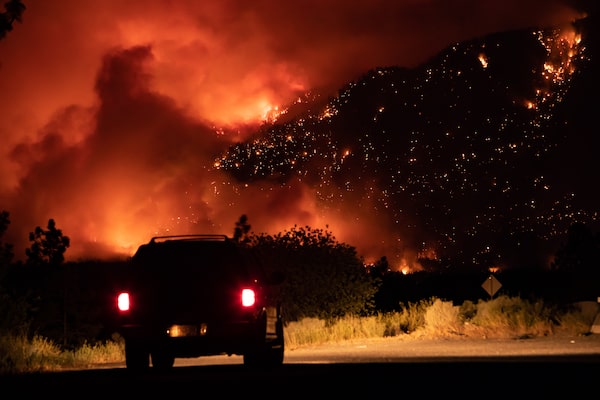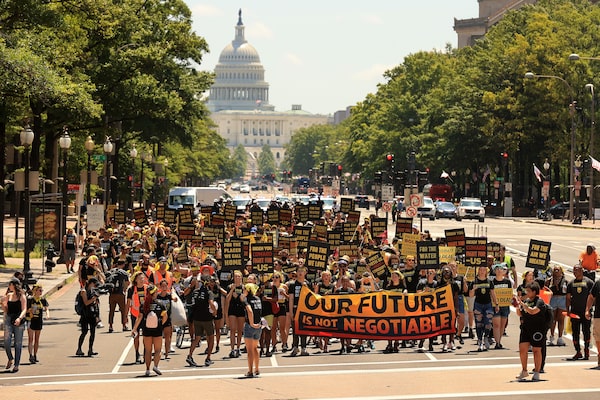If you’re reading this on the web or someone forwarded this e-mail newsletter to you, you can sign up for Globe Climate and all Globe newsletters here.
Good afternoon, and welcome to Globe Climate, a newsletter about climate change, environment and resources in Canada.
Now that we’re getting deeper into summer, let us arm you with some stories you might find useful this season.
For example, Canada’s tick seasons are getting worse, and they’re no longer just a rural menace. How can you stay safe? Then there is the far less menacing, but just a little more annoying Gypsy moth outbreak.
And finally, being outside and in the sun, here’s a recommendation to help reduce the plastic in your sunscreen.
Now, let’s catch you up on other news.
People look for ways to cool off at Willow's Beach during the 'heat dome,' currently hovering over British Columbia and Alberta as record-setting breaking temperatures scorch the province and in Victoria, British Columbia, Canada June 28, 2021.CHAD HIPOLITO/Reuters
Noteworthy reporting this week:
- A non-profit environmental organization has purchased some of British Columbia’s most threatened ecosystems, promptly ensuring that no logging or development will take place in their old-growth forests.
- The part of the Arctic Ocean that is permanently covered in sea ice is more vulnerable to climate change than previously thought, according to an international study.
- With Ottawa’s new target for electric vehicle adoption, it can’t afford to wait on Washington much longer, writes Adam Radwanski. A strong domestic market in the not-too-distant future is also likely part of the puzzle.
- The B.C. government will no longer be permitted to authorize industrial development on traditional Blueberry River First Nations territory without the community’s approval, the British Columbia Supreme Court has ruled.
A deeper dive
Heat, fire and climate change
Ryan MacDonald is The Globe’s climate, environment and resources editor. He looks at the tragedy in Lytton and it’s connection to climate change.
First the heat, then the fire.
The speed with which the tragedy unfolded in Lytton, B.C. is difficult to comprehend.
Just days after shattering Canadian heat records for three consecutive days, the village of about 300 people about three hours’ drive northeast of Vancouver was destroyed by fire.
While our western colleagues were busy telling the harrowing stories of people fleeing the fire and those who didn’t make it, the Globe’s climate and environment team set out to explain how and why climate change is to blame for the heat event and how it fuels the fires that follow.
The specific cause of the Lytton fire is under investigation, but the climate science doesn’t lie: it’s getting hotter, more often, creating dryer conditions -- and that makes our forests more susceptible to fire. Climate change is the lynchpin that allows these kind of cascading events to happen.
The world is watching as extreme weather takes hold in Canada, leaving hundreds of people dead or displaced. And tiny Lytton is at the unfortunate centre of it all.
- Worth reading: How planting trees can cool Canada’s cities in an era of climate heating
- Explainer: Western Canada’s deadly heat wave is driven by climate change. Will it be a wake-up call?
- From The Narwhal: The record-setting day when global heating surpassed COVID-19 as the existential crisis
- Ryan

A motorist watches from a pullout on the Trans-Canada Highway as a wildfire burns on the side of a mountain in Lytton, B.C., Thursday, July 1, 2021.DARRYL DYCK/The Canadian Press
What else you missed
- Ottawa to close 60 per cent of commercial salmon fisheries in British Columbia and Yukon beginning this season to conserve fish stocks that are on the “verge of collapse.”
- Old, small and CO2-intense: Why Canada’s highest-carbon oil sites keep pumping. And why rising oil prices have given them a new lease of life.
- Britain’s COP26 President Alok Sharma visited Russia to urge one of the world’s largest emitters of carbon dioxide to commit to net zero by 2050, praising Kremlin chief Vladimir Putin for his support for tackling climate change.
- The U.S. Supreme Court ruled in favour of a consortium of pipeline companies including Enbridge in N.J. land dispute.
- Countries with new fossil fuel projects should zero out emissions, U.S. climate envoy says
Opinion and analysis
Adam Radwanski: Ottawa takes a big step toward climate-change accountability - with lots of room to go further
William Shotyk and Michael Powell: The cleanest water on Earth is in Ontario. We must protect it before it’s too late
Tom Flanagan: On petroleum, First Nations are shifting from conflict to co-operation
The editorial board: The end of coal in Canada is near – and it’s about time
Green Investing
Picture of greenhouse gases tied to Canadian lending is taking shape
Vancouver City Savings Credit Union has released a report showing annual greenhouse gases emitted by its business and consumer borrowers total 105,314 tonnes, or 36 times those of its own operations. It is one of the first Canadian financial institutions to release such a report, but it won’t be the last.
Also known as financed emissions, this is a topic now getting a lot of air time. The credit union’s emissions are a tiny fraction of the global total, but how it determined the number is a good guide to the complex science of tallying greenhouse gases – and what Canada’s big banks face as they prepare their own reports.
This is the year of climate and finance, and Canada is now getting a glimpse into one of the trickiest parts of that combo.
Also: Protect nature or face huge financial losses, World Bank says
Making waves
Each week The Globe will profile a Canadian making a difference. This week we’re highlighting the work of Dr. Nadia Mykytczuk doing environmental microbiology.
Dr. Nadia MykytczukHandout
My name is Dr. Nadia Mykytczuk, I’m an environmental microbiologist, completing a Northern Ontario Heritage Fund Corporation Industrial Research Chair in Biomining, Bioremediation, and Science Communication. I am also the interim CEO and president of the Mining Innovation and Rehabilitation Applied Research Corporation and supporting the Goodman School of Mines at Laurentian University.
As a microbiologist, my research explores how bacteria can be used to extract value from mine waste, as well as remediate them to minimize impacts on the environment.
As a resident of Sudbury I’m looking to incorporate this biomining and bioremediation work into the next chapter of the city’s story.
As a research chair, I’ve been working to establish a Centre for Mine Waste Biotechnology, which would support mining companies both nationally and globally in the development and implementation of green biotechnologies in the mining sector.
I love my work, and showing that mining and the environment can work together to create sustainable mineral resources needed for clean energy technologies that will help us tackle climate change.
- Nadia
Do you know an engaged individual? Someone who represents the real engines pursuing change in the country? Email us at GlobeClimate@globeandmail.com to tell us about them.
Photo of the week

Hundreds of young climate activists march along Pennsylvania Avenue to the White House to demand that President Joe Biden work to make the Green New Deal into law on June 28, 2021 in Washington, DC.Chip Somodevilla/Getty Images
Catch up on Globe Climate
- It’s time for global standards in corporate reporting on ESG issues
- The future of coal mining under a microscope
- Alberta’s renewal begins with the end of Keystone
- How can nature repair the planet?
We want to hear from you. Email us: GlobeClimate@globeandmail.com. Do you know someone who needs this newsletter? Send them to our Newsletters page.
 Sierra Bein
Sierra Bein